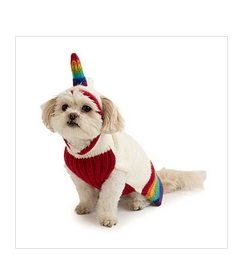“A picture is worth a thousand words.”
Many of us conclude that pictures make words unnecessary. We believe images are so explicit and clear that they communicate fully on their own.
Too often that’s not true, however. Whether of people or products, photos can be more ambiguous than most people assume. And that’s one reason it’s important for words — in the form of a caption — to accompany photos, charts, or other graphics on your site.
Confused Viewers
If the cute dog picture below from UncommonGoods caught your eye, you might be unsure of the offer. The caption, “Unicorn Pet Sweater,” though, clarifies that the dog pictured is modeling a colorful garment that dresses it up like a unicorn.

Only with the caption can the reader be sure of the offer. Source: UncommonGoods.
A vague caption can create even more confusion. For example, a flat image of a CD cover could be representing a CD, an audio download, a DVD, a streamed movie, or a book with a square shape. Careful wording is needed to vanquish doubts in the mind of the shopper.
Keep in mind too that product photos don’t necessarily reveal their scale, which can send shoppers’ minds spinning with questions.
In the snippet below from Beoplay.com, a seller of audio equipment, nothing in the photo or the product description describes the size. Is the diameter two inches or ten inches? A shopper has to click on the “tech spec” link to answer that question. Beoplay could eliminate questions about size with a photo containing, say, a hand or with a caption such as “For Audiophiles, the Beoplay A1 Traveling Speaker Fits in the Palm of a Hand.”

Neither this photo nor its initial product description indicates the item’s size. Source: Beoplay.com.
I’ve encountered other instances on ecommerce sites where photos raise questions.
- Photos for a foreign travel tour: Are the images generic street scenes or locations we’ll actually see if we book this tour?
- A young person wearing a headset: Is that picture a headset for sale or a hypothetical buyer enjoying the music, which is also for sale?
- A meal-to-go: Does the photo show the meal as it is sold, or as it looks after the buyer cooks and plates it?
Other Benefits
Informative captions also provide a search engine boost. Search engines can’t duplicate the visual perception and interpretation performed by human eyes and brains. To understand the contents of a photo, search engines rely on captions, file names, and “alt” tags.
Captions also get more attention from readers. Ad mogul David Ogilvy’s classic research found that captions get read four times more than body copy. Ogilvy also discovered that captions beneath a photo gained more readers than headlines above a photo.
And a skillfully written caption also gives you an opportunity to hit home an important point about a product. Notice the difference in these pairs of captions on a site for home-schooling parents and a swimwear outlet, respectively.
Average: “Geometry curriculum for grade 9 or 10.”
Better: “Innovative high-school geometry curriculum that excites even math-challenged students.”
Average: “Speedo Women’s Ultraback Pro H45s.”
Better: “No-tug, no-shrink Speedo Ultraback suit for serious women swimmers.”
Finally, photo captions and alt tags are critical for visually impaired shoppers who rely on screen readers. According to the Centers for Disease Control, around 3 percent of Americans aged 40 or older are visually impaired or blind. As shopping shifts online, we can expect more legal challenges to ecommerce sites that are inaccessible to this population.





